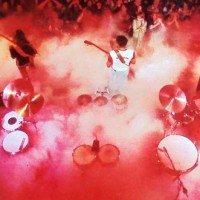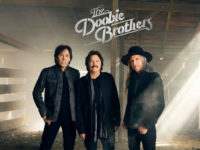There are a few genuinely great entries in the 14-album Doobie Brothers discography: I’d rate 1973’s The Captain and Me, 1976’s Takin’ It to the Streets, 1977’s Livin’ on the Fault Line and 1978’s Minute By Minute as excellent.
Looking at this list, it’s fascinating that only one is from the Tom Johnston era. That’s not a slight toward Johnston. With the exception of the debut album, the albums from that period are solid. Even the five post-break up albums are OK, with only Southbound being painful to listen to.
I pick Livin’ On the Fault Line as their best. The album had several great songs, some of the best guitar playing on a Doobie Brothers album (courtesy of Jeff Baxter), the best keyboard playing (all by Michael McDonald) and some of the best drumming (courtesy of the late Keith Knudsen).
The Doobie Brothers have sold more than 40 million albums, but the Top 10 Livin’ on the Fault Line “only” went gold. That was a step down from the previous platinum-selling Takin’ It to the Streets, which reached No. 8 on the album charts and had two Top 40 hits. Livin’ on the Fault Line, meanwhile, had no Top 40 hits. Their cover of Marvin Gaye’s “Little Darling (I Need You)” reached No. 48, while “Echoes of Love” stalled at No. 66.
This is also the first album without any contributions from Tom Johnston. He did write five songs for the album but none were included, nor did he contribute vocals or guitar. Listening to Johnston’s solo debut, 1979’s Everything You Heard Is True, it’s hard to imagine anything he wrote fitting with this album’s 35 minutes of music, primarily written by Pat Simmons and Michael McDonald.
The album opener is a case in point: “You’re Made That Way,” written by McDonald with Jeff Baxter and Keith Knudsen, seems a million miles away from “Long Train Runnin.'” McDonald’s Fender Rhodes starts things off with a funky pattern, which is enhanced by bassist Tiran Porter and Knudsen. The rhythm section has up until this point in Doobie Brothers history never played such harmonically complex parts. There are touches of rhythm guitar by Simmons but the guitar standout is Baxter, who plays lead lines mixed with McDonald’s vocals.
Congas are provided by Bobby LaKind, which adds to the backing track. Vocally, McDonald’s leads are smoky and are enhanced by his sister, Maureen, on backing vocals along with Simmons, Porter and Knudsen. Another strong addition is a young David Paich, who provides tasty horn and string arrangements for this song and four others. This is almost Steely Dan-like, especially the mid-song turnaround with the synth and horns playing off of each other. This song should have been a single.
Instead, the Doobie Brothers released “Echoes of Love,” a collaboration between Pat Simmons and Motown writers Willie Mitchell and Earl Randle. Later covered by the Pointer Sisters, this song is as far as can be from “Black Water” – which may be why it didn’t make the Top 40. It features double-drumming with Hartman, also utilizing Simmons drums in addition to his acoustic kit. The introduction is a Roland synth pattern, which is followed by Simmons’ unique picking style. Lyrically, “Echoes of Love” is compact and direct, reflecting on an old love. Even at just three minutes, there are many hook-filled elements.
“Little Darling (I Need You)” was written by Holland-Dozier-Halland, and served as the second single from Livin’ on the Fault Line. Originally done by Marvin Gaye for 1966’s Moods of Marvin Gaye album, this song seems like a natural fit for the album. It also solved the issue the band had for little time in coming up with original material after the withdrawal of Tom Johnston.
The Doobie Brothers’ arrangement is much more muscular than the original, with double drumming, congas and percussion present. McDonald’s vocals rival Gaye’s on the original, not an easy task. The backing vocals, by Simmons, Knudsen and McDonald, are equally effective. Ted Templeman mentions in his book A Producer’s Life In Music that he planned to dub a tenor sax solo onto the song, echoing Gaye’s original recording. However, during the mixing process, Jeff Baxter insisted that Patrick Simmons should provide the solo since they were a guitar band.
His solo was included in the final mix and to my ears seems like a good fit, but Templeman believes the final version would have benefitted from the sax solo. “Little Darling (I Need You)” is still strong, but was not a hit. This was the last time the Doobies included a cover song on an album, until they reformed.
The Michael McDonald/Carly Simon song, “You Belong to Me” seems like another jump away from the band’s original sound. The music, written solely by McDonald, features his Fender Rhodes with touches of rhythm guitar by Simmons and jazz lead licks by Baxter. Knudsen lays down a precise drum-machine pattern locked into Tiran Porter’s R&B-flavored bass. David Paich includes his most lush string arrangement for Livin’ on the Fault Line. There’s also a tasty horn arrangement and trumpet solo (by an uncredited performer).
Carly Simon provided the lyrics, which are robust and dark, then took her own version to No. 9 in 1978. The Doobie Brothers followed with a jazzy rearrangement, released as a single from their farewell tour in 1983. That’s the definitive take.
The title track is one of the most unusual songs in the band’s canon. Written by Pat Simmons and sung by Simmons with Michael McDonald, “Livin’ on the Fault Line” smoothly combines rock and jazz in an aggressive blend. Simmons and Baxter kick things off with a complex, interwoven jazzy intro, then the drum section of Hartman and Knudsen enter as Porter provides a counter melody on bass. In between these layers, Bobby LaKind’s congas keep a steady beat while guest vibraphonist Victor Feldman adds light colors.
“Livin’ on the Fault Line” swings like no other Doobie Brothers song. Simmons doesn’t go overboard with the lyrics, following a theme about living in tenuous times. Musically, the song could not have been stronger. Though less than five minutes long, this track contains some of the best drumming, keyboards and guitars on any Doobie Brothers album. Check out McDonald’s synth solos, Baxter’s mid-song solo, and how Feldman’s nice solo seamlessly interacts with the band. Finally, another guitar solo (most likely Baxter) over Simmons’ chunky rhythm is the icing on the cake, with Simmons’ acoustic guitar end solo as the perfect outcome.
“Nothin’ But a Heartache,” originally the opener on Side 2, finds the band in R&B territory. With Fender Rhodes, organ, bass, drums and congas prominent, the song chugs ahead. Lyrically, it’s the familiar story of boy loses girl, boy needs to move on. Vocally, McDonald saves the song from being forgettable, and the backing vocals by Porter, McDonald and Knudsen are vital. The music needs another verse and a bridge. It’s musically similar to “Keep This Train A-Rollin” from their album One Step Closer, but not as strong.
“Chinatown” is a marked contrast. Patrick Simmons composes another Steely Dan-like jazz rocker with complex time changes, navigated by Knudsen and LaKind. Baxter handles the rhythm guitars, with Simmons holding the main melody and McDonald and Simmons singing lead in tandem. McDonald provides accents with his Fender Rhodes, and almost prog-rock synth patches. Ted Templeman handles the various percussion instruments, including blocks, cowbells, and triangles.
By mid-song, the band takes off in a flight of fancy jam, which is as complex as anything they have ever done.
After the pleading vocal (“you got me under your spell”), Jeff Baxter breaks out a synthesizer guitar solo which is both compact and outer-worldly. This would be the last time the guitarist would be able to stretch his wings as a member of the Doobie Brothers.
“There’s a Light” boasts a conventional chord structure that brings the Doobie Brothers back down to the ground. Lyrically, McDonald’s lyrics are positive and uplifting. Equally involving is the pocket playing of Keith Knudsen and Bobby LaKind. There are touches of rhythm guitars and strings, but guest Norton Buffalo does the heavy musical lifting on harmonica. Sprinkle in backing vocals by Rosemary Butler, and you have a fantastic deep cut.
Bassist Tiran Porter contributes his last lead vocal as a member of the Doobie Brothers on “Need a Lady,” a rhythmically potent though slightly creepy song. Still, it’s a good vehicle for his vocal style. Additionally, “Need a Lady” finds the whole band contributing to the backing track with interlocked guitars, clavinet, percussion and backing vocals by Simmons and McDonald. Then, in a head-scratching move, Templeman calls in Dan Armstrong to fill the solo space with an electric sitar. Though he’s a renowned player, the solo should have gone to Simmons or Baxter.
Finally we have the one-minute acoustic “Larry the Logger-Two Step” by Patrick Simmons. Why? I don’t know. It’s a mysterious end to a fantastic ride.
- The Blackbyrds – ‘City Life’ (1975; 2025 reissue) - June 9, 2025
- Fernando Perdomo – ‘Waves 6’ (2025) - June 8, 2025
- Thelonious Monk – ‘Thelonious Himself’ (1957; 2025 vinyl reissue) - May 26, 2025



